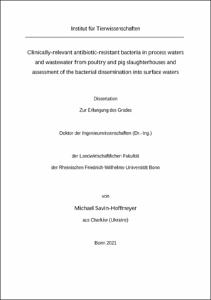Savin-Hoffmeyer, Michael: Clinically-relevant antibiotic-resistant bacteria in process waters and wastewater from poultry and pig slaughterhouses and assessment of the bacterial dissemination into surface waters. - Bonn, 2021. - Dissertation, Rheinische Friedrich-Wilhelms-Universität Bonn.
Online-Ausgabe in bonndoc: https://nbn-resolving.org/urn:nbn:de:hbz:5-60839
Online-Ausgabe in bonndoc: https://nbn-resolving.org/urn:nbn:de:hbz:5-60839
@phdthesis{handle:20.500.11811/8888,
urn: https://nbn-resolving.org/urn:nbn:de:hbz:5-60839,
author = {{Michael Savin-Hoffmeyer}},
title = {Clinically-relevant antibiotic-resistant bacteria in process waters and wastewater from poultry and pig slaughterhouses and assessment of the bacterial dissemination into surface waters},
school = {Rheinische Friedrich-Wilhelms-Universität Bonn},
year = 2021,
month = jan,
note = {The objective of this thesis was the investigation of clinically-relevant antibiotic-resistant bacteria in process waters and wastewater from poultry and pig slaughterhouses and the assessment of the bacterial dissemination into surface waters. Process waters were collected in the delivery and dirty areas of poultry and pig slaughterhouses. Their in-house wastewater treatment plants (WWTPs) were sampled as well. Furthermore, to assess the bacterial spread into surface waters, samples from the respective municipal WWTPs including the receiving water bodies were collected. The samples were screened for (1) ESKAPE-bacteria (Enterococcus spp., Staphylococcus aureus, Klebsiella pneumoniae, Acinetobacter baumannii, Pseudomonas aeruginosa, Enterobacter spp.), (2) ESBL (extended spectrum β-lactamase)-producing Escherichia coli and (3) colistin-resistant Enterobacteriaceae (i.e. E. coli, Klebsiella spp., Enterobacter spp.) by culture-dependent methods. Based on the results, the clinical relevance of the target bacteria and the efficacy of the wastewater treatment management were assessed.
From 185 water samples, a total of 1,482 isolates of the target species were recovered, which were ubiquitous along the investigated slaughtering and wastewater chains as well as in the on-site preflooders. They exhibited highly heterogeneous antibiotic-resistance patterns. Extraintestinal-pathogenic ESBL-producing E. coli was isolated to a greater extent in the samples from poultry slaughterhouses and municipal WWTPs. Furthermore, isolates originating from poultry slaugterhouses, exhibited the highest abundance of mcr-1 gene located on a variety of transferable plasmids. In the samples collected from the pig slaughterhouses, livestock-associated (LA)-MRSA of CC398 was dominant. A wide variety of clinically relevant clones among ESBL-producing, and colistin-resistant K. pneumoniae isolates was detected both in the slaughterhouses and municipal WWTPs. Of note, ESKAPE bacteria with the highest potential risk to humans, such as carbapenemase-producing Enterobacteriaceae (CPE), vancomycin-resistant enterococci (VRE) as well as healthcare-associated (HA)-MRSA of CC5 and CC22 were mainly detected in municipal wastewater.
Process waters and wastewater from slaughterhouses and especially from municipal WWTPs constitute an important reservoir of antibiotic-resistant bacteria with clinical relevance. They pose a risk to human health, since they may colonize and infect slaughterhouse and WWTPs' employees with occupational exposure to contaminated waters. The target bacteria were detected in the effluents from the in-house WWTPs of poultry slaughterhouses and municipal WWTPs, underlying their inefficacy in reducing the microbial loads. Thus, their broad dissemination into the environment can be expected. In order to reduce the input of antibiotic-resistant bacteria into the slaughterhouses and their subsequent discharge into the surface waters, the prescription and consumption patterns of antibiotics in livestock production need to be reconsidered. Furthermore, use of innovative state-of-the-art wastewater treatment technologies needs to be encouraged, especially for direct dischargers.},
url = {https://hdl.handle.net/20.500.11811/8888}
}
urn: https://nbn-resolving.org/urn:nbn:de:hbz:5-60839,
author = {{Michael Savin-Hoffmeyer}},
title = {Clinically-relevant antibiotic-resistant bacteria in process waters and wastewater from poultry and pig slaughterhouses and assessment of the bacterial dissemination into surface waters},
school = {Rheinische Friedrich-Wilhelms-Universität Bonn},
year = 2021,
month = jan,
note = {The objective of this thesis was the investigation of clinically-relevant antibiotic-resistant bacteria in process waters and wastewater from poultry and pig slaughterhouses and the assessment of the bacterial dissemination into surface waters. Process waters were collected in the delivery and dirty areas of poultry and pig slaughterhouses. Their in-house wastewater treatment plants (WWTPs) were sampled as well. Furthermore, to assess the bacterial spread into surface waters, samples from the respective municipal WWTPs including the receiving water bodies were collected. The samples were screened for (1) ESKAPE-bacteria (Enterococcus spp., Staphylococcus aureus, Klebsiella pneumoniae, Acinetobacter baumannii, Pseudomonas aeruginosa, Enterobacter spp.), (2) ESBL (extended spectrum β-lactamase)-producing Escherichia coli and (3) colistin-resistant Enterobacteriaceae (i.e. E. coli, Klebsiella spp., Enterobacter spp.) by culture-dependent methods. Based on the results, the clinical relevance of the target bacteria and the efficacy of the wastewater treatment management were assessed.
From 185 water samples, a total of 1,482 isolates of the target species were recovered, which were ubiquitous along the investigated slaughtering and wastewater chains as well as in the on-site preflooders. They exhibited highly heterogeneous antibiotic-resistance patterns. Extraintestinal-pathogenic ESBL-producing E. coli was isolated to a greater extent in the samples from poultry slaughterhouses and municipal WWTPs. Furthermore, isolates originating from poultry slaugterhouses, exhibited the highest abundance of mcr-1 gene located on a variety of transferable plasmids. In the samples collected from the pig slaughterhouses, livestock-associated (LA)-MRSA of CC398 was dominant. A wide variety of clinically relevant clones among ESBL-producing, and colistin-resistant K. pneumoniae isolates was detected both in the slaughterhouses and municipal WWTPs. Of note, ESKAPE bacteria with the highest potential risk to humans, such as carbapenemase-producing Enterobacteriaceae (CPE), vancomycin-resistant enterococci (VRE) as well as healthcare-associated (HA)-MRSA of CC5 and CC22 were mainly detected in municipal wastewater.
Process waters and wastewater from slaughterhouses and especially from municipal WWTPs constitute an important reservoir of antibiotic-resistant bacteria with clinical relevance. They pose a risk to human health, since they may colonize and infect slaughterhouse and WWTPs' employees with occupational exposure to contaminated waters. The target bacteria were detected in the effluents from the in-house WWTPs of poultry slaughterhouses and municipal WWTPs, underlying their inefficacy in reducing the microbial loads. Thus, their broad dissemination into the environment can be expected. In order to reduce the input of antibiotic-resistant bacteria into the slaughterhouses and their subsequent discharge into the surface waters, the prescription and consumption patterns of antibiotics in livestock production need to be reconsidered. Furthermore, use of innovative state-of-the-art wastewater treatment technologies needs to be encouraged, especially for direct dischargers.},
url = {https://hdl.handle.net/20.500.11811/8888}
}






